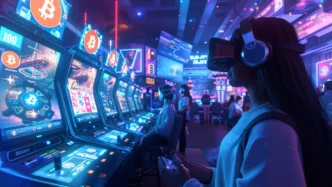Virtual reality (VR) technology has risen to prominence as a groundbreaking innovation across various fields, including gaming. This technology creates immersive experiences that transport users into different worlds, allowing them to engage in ways previously thought impossible. Over the years, VR has evolved significantly, moving from niche markets into mainstream applications. One of the most thrilling fields where VR is significantly influencing is in the iGaming industry. This industry encompasses online gambling, betting, and casino gaming. With VR, players can enjoy experiences that closely mimic real-life gaming environments, enhancing their overall enjoyment. As this technology becomes more integrated, it is emerging as a transformative influence in the iGaming industry.
VR allows players to enter a virtual casino and engage with fellow players and dealers, and participate in games that feel incredibly real. As the technology develops, it promises to change the ways in which players interact with online gambling platforms. This article explores the various aspects of VR in iGaming, from its definition and advantages, the obstacles it encounters, and its prospects ahead potential.
1. What is Virtual Reality in iGaming?
Definition and Applications
Virtual reality in iGaming refers to the use of VR technology to enhance the gaming experience. Players can wear VR headsets that immerse them in a virtual world designed specifically for gaming. This world can replicate a real casino or create fantastical environments that stimulate the imagination. Players can interact with these environments using VR controllers, which enable various actions such as placing bets, grabbing virtual cards, or pulling the lever on a slot machine.
The applications of VR in iGaming are numerous. Beyond traditional casino games, VR can enhance sports betting by creating immersive viewing experiences. Players can experience the sensation of being in the stands of a sports event, placing bets while enjoying the atmosphere. Additionally, VR can facilitate social gambling experiences, enabling players to engage and compete with friends or other participants worldwide.
How VR Works in Online Gaming
In VR gaming, players use headsets that monitor their movements. These movements are mirrored in the game, facilitating seamless interactions within the virtual space. When a player looks around, they see a 360-degree view of their surroundings. This feeling of presence is essential for immersion, as it allows players to truly feel like they are part of the gaming world.
Players can also use controllers to engage with the surroundings. These controllers typically feature buttons and triggers that let users perform various actions, such as placing bets or interacting with game elements. Some VR systems may also support haptic feedback devices that deliver tactile sensations to deepen the immersive experience.
The technology behind VR relies on advanced graphics and real-time rendering, enabling lifelike environments that respond to players’ actions. This real-time feedback creates a dynamic and captivating experience that keeps players interested in the game.
History of VR in Gaming
The idea of virtual reality is not a recent development. VR has been a part of gaming for decades, but it has only recently gained traction in the iGaming sector. Early attempts at VR in gaming faced significant difficulties arising from technological constraints and high costs. The hardware was bulky and expensive, and the graphics were often underwhelming compared to traditional gaming platforms.
However, recent advances in technology have made VR more accessible and appealing. The development of affordable VR headsets, improved graphics engines, and faster internet connections has paved the way for VR’s integration into online gaming. Businesses are increasingly investing in the development of high-quality VR experiences tailored specifically for the iGaming audience. This surge in interest has led to increased investment in developing VR games that provide players with engaging and immersive experiences.
2. Key Benefits of VR in iGaming
Immersive Experience
One of the standout features of VR is its ability to create realistic environments. Players can experience the sensation of being truly inside a casino or a betting arena. The sights and sounds of a virtual gaming environment enhance the experience, providing an authenticity that traditional online games cannot replicate.
In a VR casino, players can explore the virtual environment, check out various gaming tables, and interact with other players and dealers. This level of immersion makes gaming more engaging and enjoyable, as players can escape from reality and immerse themselves in a completely different world.
Moreover, the ability to customize avatars and personalize experiences adds another layer of engagement. Players can express their identities through their avatars, enhancing their connection to the gaming environment.
Enhanced Social Interaction
Social interaction is a vital part of gaming, and VR offers unique opportunities for multiplayer experiences. Players can engage with one another in real-time, making the gaming experience more engaging and interactive. They can chat, strategize, or even celebrate wins together. This degree of interaction encourages a feeling of community among players, creating a more enjoyable and lively gaming atmosphere.
In traditional online gaming, communication often happens through chat boxes or voice calls. In VR, players can see each other’s avatars and engage in face-to-face conversations, making interactions feel more genuine. This enhanced social experience can lead to lasting friendships and a stronger sense of belonging within the gaming community.
Higher Engagement and Retention Rates
The immersive nature of VR captures players’ attention in ways that traditional gaming methods cannot. When players are fully engaged in a virtual environment, they are more inclined to play for extended periods. This heightened engagement can result in better retention rates, indicating that players are more inclined to return to the game repeatedly.
iGaming operators benefit from this increased engagement. Higher retention often translates to increased revenue, as players who spend more time in the game are likely to place more bets and participate in more gaming activities. Operators can also leverage this engagement by offering personalized experiences and incentives to keep players coming back.
Increased Trust
Transparency is crucial in the gambling industry. VR can enhance trust by allowing players to see the entire game process. For instance, in games like poker or roulette, players can observe the action as if they were at a real table. This visibility can help reduce concerns about fairness and integrity.
When players can see the cards being dealt or the roulette wheel spinning, they are more inclined to have confidence in the game’s outcome. This heightened trust can result in greater player satisfaction and loyalty, benefiting both players and operators.
3. Popular VR Games and Experiences in iGaming
Overview of Popular VR Casino Games
The landscape of VR casino gaming is rapidly expanding. Popular games in this genre include poker, slots, blackjack, and roulette. Each of these games is designed to leverage the immersive capabilities of VR. In VR poker, players can read their opponents’ body language, adding a psychological element to the game.
Slots games in VR often feature vibrant graphics and engaging features that improve the gaming experience. Players can pull levers, watch reels spin, and even enjoy animated sequences that bring the game to life. Blackjack and roulette games offer players the opportunity to interact with dealers and other players in real-time, creating a social and immersive experience.
VR Sports Betting and Live Events
VR is making an impact in the sports betting industry as well. Players can experience live events in a virtual setting, creating an exciting and interactive way to place bets. Imagine watching a live football match from the comfort of your home while feeling as though you are sitting in the stadium. This extent of immersion amplifies the excitement of betting, as players can feel the atmosphere of the event.
In VR sports betting environments, players can wager while observing the action as it happens in real-time. This engagement creates a thrilling atmosphere that traditional betting lacks. Players can share their experiences with friends, creating a social betting experience that adds to the excitement.
VR-Based Tournaments and eSports Betting
Tournaments are a big part of the gaming world, and VR opens up new possibilities for competitive play. Players can challenge one another in engaging environments, enhancing the thrill of competition. eSports betting in VR creates a dynamic experience that draws in fans.
In VR tournaments, players can feel as though they are part of the action, cheering for their favorite teams while placing bets. Such engagement can lead to improved participation in tournaments and a more vibrant gaming community.
Success Stories
Several companies are leading the charge in VR iGaming. These pioneers are developing innovative games that expand the limits of what can be achieved. For example, companies like NetEnt and Evolution Gaming have made significant strides in creating VR gaming experiences. Their success stories highlight the potential of VR to reshape the gaming landscape. With more companies entering this market, the competition will encourage further advancements, leading to even more exciting developments in VR iGaming.
4. Technical Requirements for VR in iGaming
Hardware
To fully enjoy VR experiences, players need specific hardware. High-quality VR headsets, such as the Oculus Rift, HTC Vive, and PlayStation VR, are essential. These devices provide the immersive visuals that define VR gaming. Controllers are also necessary for participation in the virtual space. These controllers allow players to interact with game features, enhancing the experience to be more engaging and user-friendly
Some setups may include additional accessories, such as motion sensors or haptic gloves, to enhance the experience further. These devices can provide tactile feedback, enabling players to sense the surroundings around them. For instance, haptic gloves can simulate the sensation of holding cards or chips, adding to the realism of the gaming experience.
Software and Compatibility
Not all gaming platforms support VR technology. Players must ensure that their chosen gaming platform is compatible with their VR headset. Popular VR platforms like Oculus and SteamVR offer a range of VR games, including those in the iGaming sector.
iGaming operators also need to develop software that can seamlessly integrate with VR technology. This integration includes creating user-friendly interfaces, optimizing graphics, and ensuring smooth gameplay to enhance the overall experience. As the technology evolves, we can expect more platforms to support VR gaming.
Network Requirements
A reliable internet connection is crucial for enjoying VR gaming. High-speed internet with low latency is necessary to ensure smooth gameplay. Lag or delays can greatly diminish the immersive experience, making it frustrating for players.
For VR gaming to thrive, players need to have a robust internet connection. This requirement may limit access for some players, particularly in regions with unreliable internet connectivity. As technology improves, we can expect greater accessibility to high-speed internet, benefiting the VR gaming community as a whole.
5. Challenges in VR Adoption for iGaming
High Initial Cost
While VR technology has become more accessible, the initial cost can still be prohibitive for many players. Premium VR headsets and accessories can come with a hefty price tag, deterring some potential users from engaging with VR gaming. Additionally, iGaming operators may face significant costs in developing VR content and platforms, which can impact their ability to invest in new technologies.
For VR to achieve widespread adoption, both players and operators need to consider the cost-benefit ratio. As technology evolves, prices are expected to drop, making it more available to a wider audience.
Limited Accessibility
Not all players have access to the necessary hardware for VR gaming. Many users may not own VR headsets or might lack the space to install VR equipment. This limitation can hinder the growth of VR in the iGaming industry, as not all players can participate in these immersive experiences.
To counteract this challenge, iGaming operators can consider offering alternative gaming options that do not require VR technology. By providing a range of options, they can cater to a wider audience while still promoting the benefits of VR.
Technology Limitations
While VR technology has advanced significantly, there are still limitations to consider. Graphics and processing power can affect the overall quality of the VR experience. Top-notch visuals are crucial for achieving immersion environments, but not all devices can deliver this level of performance.
Latency can also be a concern in VR gaming. Any lag between a player’s actions and the response in the game can break immersion and lead to frustration. Continuous advancements in technology will be necessary to address these limitations and enhance the overall VR gaming experience.
Regulatory Concerns
The integration of VR technology in iGaming raises legal and ethical questions. Regulators must consider how VR gambling will fit within existing laws and regulations. Concerns including player safety, fair play, and responsible gambling practices must be addressed.
Regulatory bodies will need to work with iGaming operators to create guidelines that ensure a safe and fair environment for players. By proactively addressing these concerns, the industry can establish trust and credibility among players.
Privacy and Security
As VR gaming becomes more immersive, players may share more personal data with gaming platforms. This increased data sharing raises worries regarding privacy and security. Players need to feel confident that their information is safe within virtual environments.
iGaming operators must implement robust security measures to protect players’ data. This includes encryption, secure payment options, and clear privacy policies. Establishing trust in the security of VR gaming environments is crucial for long-term success.
6. The Future of VR in iGaming
Expected Advancements in VR Technology
The future of VR in iGaming looks promising. Ongoing advancements in hardware and software will probably result in even more immersive experiences.High-resolution displays, improved graphics, and faster processing power will enhance the overall quality of VR gaming.
As technology advances, we can anticipate new features that further engage players. Innovations in haptic feedback, eye tracking, and motion sensing will create even more realistic experiences, blurring the lines between virtual and real.
Integration of AI and VR
The integration of artificial intelligence (AI) and VR has the potential to revolutionize the gaming experience. AI can enhance player interactions by personalizing experiences based on individual preferences. For example, AI algorithms are capable of analyzing a player’s gaming habits to recommend tailored gaming options, bonuses, or challenges.
Combining AI with VR can also lead to the creation of interactive game environments that react to player actions. This adaptability will enhance immersion, creating a more engaging and personalized experience.
Future Trends: 3D Casinos and Holographic Gaming
As technology advances, we may see the rise of 3D casinos that offer immersive experiences without the need for VR headsets. These casinos could provide stunning visuals and interactive elements, allowing players to explore virtual environments from their computers or mobile devices.
Holographic gaming is another exciting possibility. As holographic technology advances, players may interact with 3D holograms projected into their living spaces. This level of interaction could revolutionize gaming, providing a distinctive mix of physical and virtual components.
The Role of Metaverse and Web3 Technologies
The Metaverse and Web3 technologies are expected to play significant roles in shaping the future of VR in iGaming. The Metaverse provides a communal virtual environment for players to connect, compete, and gamble in immersive environments. This interconnectedness can lead to new gaming experiences that promote community and teamwork.
Web3 technologies, emphasizing decentralization and user ownership, may also impact how iGaming operates. These technologies can introduce new business models, enhancing player engagement and increasing transparency within the industry. As players obtain greater control over their gaming experiences, the landscape of iGaming could change dramatically.
Conclusion
Virtual reality is poised to transform the iGaming landscape in profound ways. Its ability to create immersive experiences, enhance social interactions, and foster player trust makes it a valuable addition to the gaming world. Nonetheless, issues like cost, accessibility, and regulatory concerns need to be resolved for broad adoption.
As technology progresses, the outlook for VR in iGaming looks promising. Players can look forward to exciting advancements that will improve their gaming experiences. Finding a balance between innovation and responsible practices will be crucial for the growth and sustainability of VR in the iGaming industry. By navigating these challenges, stakeholders can ensure that VR becomes an integral part of the online gaming experience.
Related posts:













